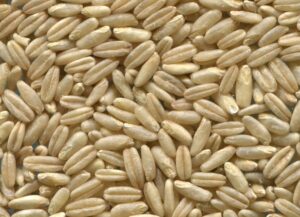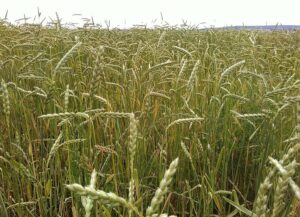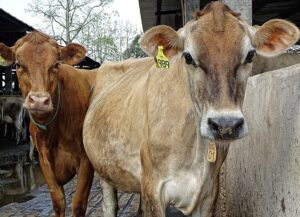Alvaro Garcia
Modern improved dairy cow genetics require energy dense rations in order to fulfill their requirements. As a result, cows in farms with high milk production oftentimes receive diets where grain constitutes no less than 60% of the formulation. Similarly, there are parts of the world where forages have become scarce and/or very expensive since they must be hauled long distances or even imported from overseas.
Under these scenarios dairy cows are challenged with grain concentrations oftentimes borderline with digestive upsets, particularly sub-clinical acidosis and in extreme cases clinical acidosis and even displaced abomasum.
Today’s corn varieties have been improved compared to those in the past and contain slightly above 20% more starch or close to 74-75%. In the corn kernel starch is in the endosperm encased in starch granules embedded in a hydrophobic prolamin-rich protein matrix, which protects it from enzymatic degradation. In order to increase the utilization of starch this matrix must be disrupted, usually by physical methods.
How to improve corn digestibility in dairy cows
These methods vary in their effectiveness depending on the type of grain and the different process, affecting in consequence the productive response of the cows. One of these methods, the reduction in particle size, has long been recognized as an effective method to increase starch utilization by livestock. Research has reported that reducing the particle size from 4,000 to 500 μm increased total-tract starch digestibility from 77.7 to 93.3%.
The larger the particle the greater the resistance of this protein matrix to water infiltration and the accessibility of starch-degrading enzymes both from the microorganisms in the rumen and the cow enzymes in the small intestine. However, the particle size excessively can greatly increase starch availability and result in the digestive upsets mentioned above, particularly acidosis.
Aside from the particle size reduction, one other method is steam flaking. Moisture and heat applied during this process disrupts the protein matrix that protect the starch and allows for easier enzyme penetration.
Steam flaking corn is frequently used in the US to improve starch digestibility both for dairy and beef cattle. As a result, diets with steam-flaked corn improve weight gains in feedlot cattle, and milk yield, milk protein yield, fat-corrected-milk (FCM) and solid-non-fat (SNF) in dairy cattle.
Results have also shown that cow performance fed diets with steam-flaked versus fine-ground corn can be similar and result in more ruminal VFA, greater total tract starch digestibility, and ultimately increased milk production. In addition, it has been speculated that cows receiving diets with these processed grains, would select longer fibrous particles to increase saliva production through chewing, and thus buffer the reduction in rumen pH.
A recent study (Ahmadi et al. 2020) evaluated the effects of diets containing steam flaked corn (SFC) or ground corn (GC) varying in particle size (fine = FGC, medium = MGC or coarse = CGC) on performance, ruminal characteristics, nutrient digestibility, and sorting index of high producing dairy cows fed high-concentrate diets.
Comparing ground corn with steam flake corn
Multiparous Holstein cows with 101 ± 10 days in milk (DIM), body weight (BW) of 607 ± 62 kg, milk yield of 46.6 ± 3.5 kg/day were used in a double 4 × 4 Latin square design. There were 21-day periods consisting of 13 days for adaptation and 8 d for sampling and data collection. Cows within each square were assigned to four dietary treatments as follows:
- FGC, TMR containing finely ground corn = 0.73 ± 0.2 mm.
- MGC, TMR containing medium ground corn (0.84 ± 0.28 mm);
- CGC, TMR containing coarse ground corn (1.08 ± 0.68 mm);
- SFC, TMR containing SFC (density of 400 g/L).
Cows were fed a TMR with a forage: concentrate ratio of 36:64 on a DM basis, with corn silage and chopped alfalfa hay as the forage components. Experimental diets were formulated using the Cornell Net Carbohydrate and Protein System to meet the energy and protein requirements of cows (650 kg of BW, 100 DIM) producing 46.6 kg/day of milk (3.2% fat and 3.0% protein) and consuming 24.9 kg/day DM.
Alfalfa hay was chopped to a theoretical length of cut of 30 mm; corn silage was stored in a bunker silo and sampled on a weekly basis for DM content adjusting its inclusion in the TMR accordingly.
Corn was steam flaked in a vertical stainless-steel chamber at 99°C for 30 minutes, with moisture in the chamber raised to 18% before the corn passed through a pre-heated roller mill (46 × 90 cm in size) to produce flakes (density of 400 g/L). Corn kernels were ground using a hammer mill and passed through sieves with mesh sizes of 2, 3, and 4 mm for the FGC, MGC, and CGC, respectively.
Diets contain steam flake corn increase milk fat content
Results showed that steam flaking and grinding corn grains to different particle sizes had no effect on DM intake, milk production, 3.5% FCM, ECM, fat, or milk protein. Milk fat content however was greater for diets containing steam-flaked corn versus ground corn. Feeding steam-flaked corn and corn finely ground to 0.73 mm improved DM digestibility; however, cows fed steam-flaked corn had lower starch digestibility than cows fed ground corn.
Digestibility of DM and organic matter were greater for fine ground corn and steam-flaked corn than the other diets. In addition, cows fed steam-flaked corn had lower total-tract starch digestibility than cows fed ground corn. Ruminal pH increased, whereas total volatile-fatty-acids (VFA) concentration decreased with steam-flaked corn compared with ground corn diets.
Cows fed steam flaked corn tended to have lower molar proportion of propionate (22.8 vs. 27.1 mM) and total volatile fatty acid concentration (88.6 vs. 99.8 mM) in ruminal fluid than those fed ground corn diets. Ruminal pH (6.46 vs. 6.01) as well as milk fat content (2.75 vs. 2.59%) and efficiencies (fat corrected milk/DM intake and energy-corrected milk/DM intake) were greater for steam flaked corn than ground corn and were not affected by particle size. Milk fat content tended to increase with increasing particle size of ground corn.
Eating activity (min/day) tended to be less for steam flaked corn compared to ground corn. Rumination activity (min/day) and total chewing activity (min/day) were not affected by processing or particle size. Feed efficiency (FCM/DM intake) was greater for diets containing steam-flaked corn compared to ground corn.
This study suggests that steam-flaked corn to 400 g/L density can improve feed efficiency, DM digestibility, and ruminal conditions, resulting in higher milk fat content. In dairy cows producing more than 45 kg/day and DM intake above 24 kg/day, corn flaking may improve rumen health and milk fat content without decreasing milk yield.
Reference
F. Ahmadi, G.R. Ghorbani, A. Sadeghi-Sefidmazgi, M Heydari, H. Rafiee, K.A. Beauchemin. Performance and Feeding Behavior of Dairy Cows Fed High-Concentrate Diets Containing Steam-Flaked or Ground Corn Varying in Particle Size. J Dairy Sci. 2020 Apr;103(4):3191-3203.
© 2020 Dairy Knowledge Center. All Rights Reserved.









